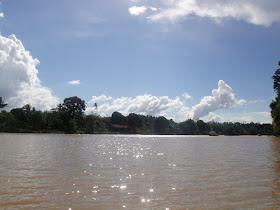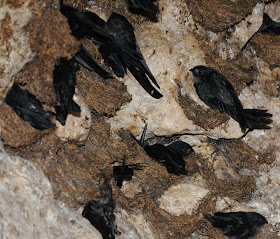Instead of using one of the jungle lodges along the Kinabatangan, we opted for a home stay with a group of Malaysian families - an interesting alternative.
Our hosts kept a few local birds in (very small) cages. These are Blue-crowned Hanging Parrots (Loriculus galgulus), among the smallest mermbers of the parrot family.
This is a northeast Borneo endemic, the White-crowned Shama (Copsychus stricklandi), often included as a race of the much more widespread White-rumped Shama (C. malabaricus). Shamas are still common birds, but they are intensely trapped everywhere for their colourful plumage and beautiful song, and their days of abundance may be numbered.
Not all the wildlife around the house were caged, of course. In the garden just outside the door an Olive-backed Sunbird (Cinnyris jugularis) was building her nest, with no apparent concern for human comings and goings.
Equally unconcerned about us - perhaps fortunately - were the architects of this elegant little wasp's nest just outside our house door.
Beyond the house, the river beckoned....
And we set out (carefully) to explore the forest along its banks.
Though, as I wrote in my last post, the forest has been much reduced by the spread of oil palm, it still boasts beautiful flowering trees and the occasional tall emergent soaring above the rest of the canopy.
And there is still wildlife. Once or twice we found large Water Monitors (Varanus salvator) lounging on the banks.
At one point a shelf of rock overhangs the river edge, and here we found nesting Glossy Swiftlets (Collocalia esculenta) sharing the rock face with a colony of bats.
Bats can be tricky to identify without a specimen in hand, especially for a complete non-expert like me. I think, however, that this is one of the horseshoe bats (Hipposideridae); which one, I won't hazard a guess. Any chiropterologists out there?
Humans, of course, are busy along the river (including tourists like ourselves). Well, "busy" may be a relative term; these forest rangers didn't seem to have a great deal to do.
Fishermen are, perhaps, more active.We came across a few traditional fishing traps along the water's edge...
This one, which our guide hauled up for us to inspect, had already caught some freshwater prawns - delicacies that are becoming scarce in many areas as chemical residue from oil palm plantations and other sources runs off into the rivers.
This barge and its accompanying tug, carriers for dredged river sand, are evidence of human activity on a much more industrial scale.
Humans, of course, are busy along the river (including tourists like ourselves). Well, "busy" may be a relative term; these forest rangers didn't seem to have a great deal to do.
Fishermen are, perhaps, more active.We came across a few traditional fishing traps along the water's edge...
This one, which our guide hauled up for us to inspect, had already caught some freshwater prawns - delicacies that are becoming scarce in many areas as chemical residue from oil palm plantations and other sources runs off into the rivers.
This barge and its accompanying tug, carriers for dredged river sand, are evidence of human activity on a much more industrial scale.
What effect dredging and similar activities will have on the prawns and other life of the river, and on local livelihoods from fishing to tourist guiding, remains to be seen, but the presence of the barge was a keen reminder that even in a famous wilderness area the hand of industrial humanity may not be far away.




















No comments:
Post a Comment